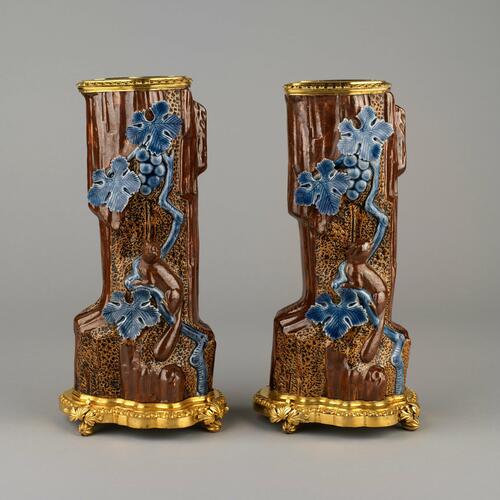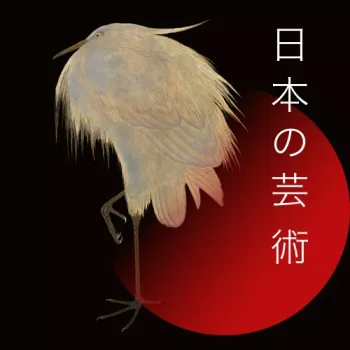Pair of wall vases with mounts vases: 1650-1700, mounts: first half 18th century
Porcelain with blue and brown glazes with gilt bronze | 25.8 x 12.0 x 10.0 cm (whole object) | RCIN 3574
-
These vases represent an ingenious visual pun or rebus. In Mandarin, the word for ‘squirrel’ is a homonym for ‘pine’, and the word ‘grape’ is a homonym for ‘peach’. Pines and peaches are symbols of longevity in China and Korea, and so the combination of bushy-tailed squirrels and grapevines is a cleverly expressed wish for long life. Grapes additionally indicate the desire for abundant offspring, for the phrase wan dai can be translated as both ‘10,000 hanging [grapes]’ and ‘10,000 generations’. These borrowings indicate the strong influence of Chinese symbols and motifs on early Japanese export porcelain.
Each vase is moulded and glazed to resemble a tree stump, and their backs have been pierced with a hole for suspension. They were mounted in France and almost certainly later acquired by George IV. They furnished the Yellow Bow Room at the Royal Pavilion, Brighton in 1829 and were sent to Buckingham Palace in March 1847.
A pair of Japanese porcelain wall vases mounted with French gilt bronze. Moulded as a tree stump with trimmed bark, with a knobbly surface glazed deep brown, and on the front a grape vine with leaves and fruit in blue, perched on which is a brown squirrel with bushy tail; the base unglazed. Pierced in the flattish back below the top is a hole for suspension. On the mouth is a beaded gilt-bronze rim with a fluted border, the foot with a flat projecting base of irregular form, with similar border and four leaf-and-bud feet, two square holes in the corners of the base, for adapting as a light fitting (now redundant).
The base cast with shells, rocks and seaweed accompany a pair of parrot candelabra in the Residenz, Munich, probably acquired for the Elector of Bavaria (either Maximilian II Emanuel or his son Karl Albrecht) from a Parisian marchand-mercier.
Texted adapted from Chinese and Japanese Works of Art in the Collection of Her Majesty The Queen: Volume II and Japan: Courts and Culture (2020)
Provenance
Almost certainly George IV. Formerly in the Yellow Bow Room at the Royal Pavilion, Brighton, and described in the Inventory as ‘A pair of brown China trunk Jars with embossed squirrels & blue fruited Vines, mounted with shaped rims & bases of ormolu on gourd feet, ten inches [25.4 cm]’ (1829B, p. 86); sent to Buckingham Palace in March 1847 (1829A, p. 31), and noted there in March 1914, in Room No. 129, Chamber Floor (Brighton Pavilion Inventory of Clocks and China 1828, p. 112), and in 1921, in Room No. 136, Chamber Floor (1829B, p. 86).
-
Creator(s)
(nationality)(metalworker)Acquirer(s)
-
Medium and techniques
Porcelain with blue and brown glazes with gilt bronze
Measurements
25.8 x 12.0 x 10.0 cm (whole object)
Category
Object type(s)
Other number(s)









